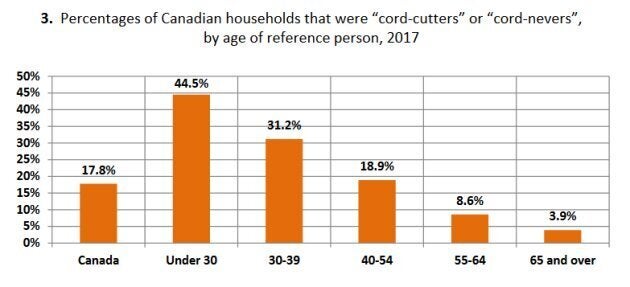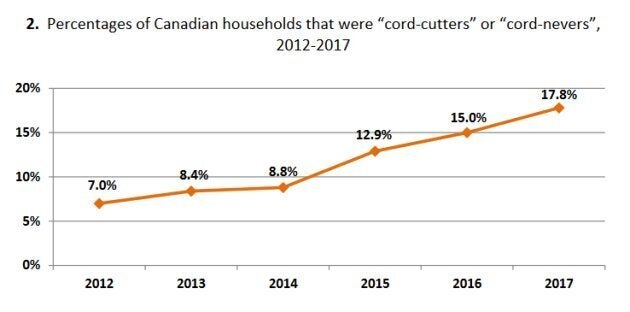
If the habits of Canada's youngest independent households are a sign of things to come, the country's traditional cable and satellite TV providers will need to rethink their businesses.
According to data from Winnipeg-based media consultancy Communications Management Inc., close to half of Canada's households headed by someone under 30 are "cord-cutter" or "cord-never" households, meaning they ditched cable or satellite TV, or never had it in the first place.
Using data from a Statistics Canada household spending survey released in December, the study found that 44.5 per cent of under-30 households don't have cable or satellite.
That compares to 31.2 per cent among those aged 30 to 39, and 18.9 per cent among the 40 to 54 crowd. Among those aged 65 and up, just 3.9 per cent cut the cord, or never had it.

Among all Canadian households, 17.8 per cent are now cord-cutters or cord-nevers, up from around 7 per cent in 2012.

Although comparable numbers are hard to come by, it appears the shift away from cable and satellite is slower in Canada than it is in the U.S. A 2018 survey from eMarketer estimated that nearly 33 per cent of American adults will have ditched cable by the end of this year.
The faster pace of cord-cutting in the U.S. may simply have to do with the fact that alternatives to cable have been slower to arrive in Canada.
Watch: What's new on Netflix Canada in January. Story continues below.
But some analysts say something else is going on: Americans may not be ditching live TV altogether at a much faster pace; rather, many are switching to internet-based services that offer live TV channel packages.
In the U.S., numerous such services have sprung up, such as Sling, DirecTV Now, YouTube Live, PlayStation Vue and Hulu Live. These services tend to be less expensive than traditional cable packages, and those who switch to them are counted as having cut the cord.
Canada has fewer of these services and those that exist — Bell's Fibe TV or Telus' Pik TV — are priced similar to traditional cable packages.
Earlier on HuffPost Canada:
Also, Canada's large telecoms own a lot of broadcast content, particularly sports, so they have a "larger vested interest to protect the traditional linear video subscriber base," Scotiabank analyst Jeff Fan told MobileSyrup last year.
In an analysis released last October, Fan and fellow analyst Matthew Hofmann predicted that streaming service subscriptions in Canada would exceed traditional cable and satellite subscriptions this year or next.
They found that sports is one thing keeping many viewers from cutting the cord — and that's good for Canada's TV distributors.
"If Canadian broadcasters cannot beat the global (streaming) services, then we believe they should produce content (especially local content) to sell to the latter."Scotiabank analysts, in an October 2018 report
"Both Rogers and BCE own major sports franchises, the two top sports broadcasters and are also two of the largest TV service distributors in Canada," the Scotiabank report noted.
As for broadcasters, Fan and Hoffman suggested they get in on the boom in TV production spurred by the rise of streaming services.
"If Canadian broadcasters cannot beat the global (streaming) services, then we believe they should produce content (especially local content) to sell to the latter," they wrote.
They noted that more than half of Netflix's original content is now produced outside the U.S.
"This is an opportunity for many markets, including Canada."